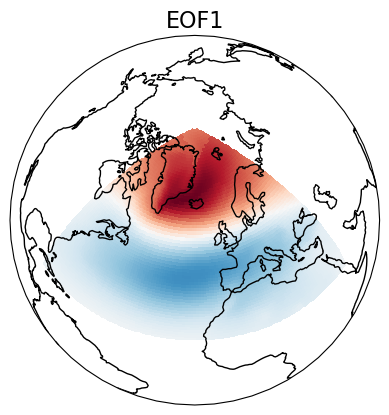Introduction to EOFS#
#!wget https://downloads.psl.noaa.gov/Datasets/COBE/sst.mon.mean.nc
import numpy as np
from scipy import signal
import numpy.polynomial.polynomial as poly
import matplotlib.pyplot as plt
from eofs.xarray import Eof
import cartopy.crs as ccrs
import cartopy.feature as cfeature
n_samples = 1000
x1 = np.random.normal(0, 2, n_samples)
x2 = 0.8 * x1 + np.random.normal(0, 1, n_samples)
data = np.vstack((x1, x2)).T # Combine into a 2D array
ds = xr.DataArray(data, dims=("time", "space"), coords={"space": ["X1", "X2"]})
fig, ax = plt.subplots(figsize=(8, 6))
plt.scatter(x1, x2, alpha=0.6, label="Data")
plt.grid(True)
plt.show()
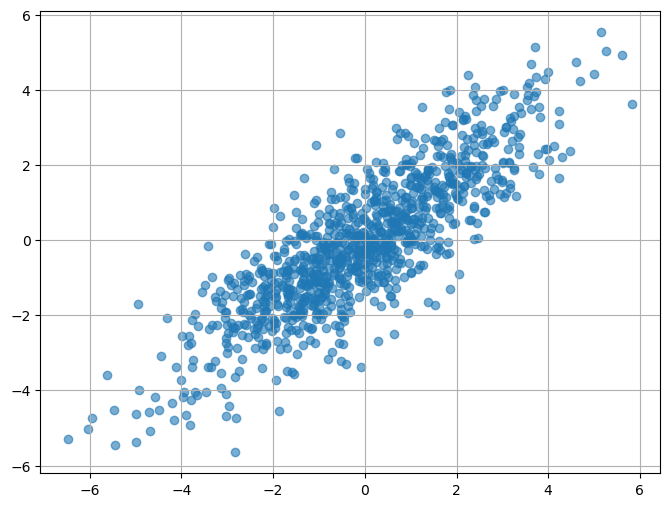
solver = Eof(ds)
eofs = solver.eofs(neofs=2) # Get EOF spatial patterns
pcs = solver.pcs(npcs=2, pcscaling=1) # Get principal components
plt.quiver(0, 0, eofs.isel(mode=0)[0], eofs.isel(mode=0)[1])
plt.quiver(0, 0, eofs.isel(mode=1)[0], eofs.isel(mode=1)[1])
<matplotlib.quiver.Quiver at 0x7faf068e0150>

mean_x1, mean_x2 = np.mean(x1), np.mean(x2)
scaling = 5 #
fig, ax = plt.subplots(figsize=(8, 6))
plt.scatter(x1, x2, alpha=0.6, label="Data")
plt.grid(True)
plt.quiver(mean_x1, mean_x2, eofs.sel(space="X1")[0] * scaling, eofs.sel(space="X2")[0] * scaling,
color="red", scale_units="xy", scale=1, label="EOF 1")
# EOF2: Second dominant axis
plt.quiver(mean_x1, mean_x2, eofs.sel(space="X1")[1] * scaling, eofs.sel(space="X2")[1] * scaling,
color="blue", scale_units="xy", scale=1, label="EOF 2")
# Plot styling
plt.axhline(0, color="grey", lw=0.5)
plt.axvline(0, color="grey", lw=0.5)
plt.xlabel("X1")
plt.ylabel("X2")
plt.title("Scatter Plot with EOF Axes (using eofs)")
plt.legend()
<matplotlib.legend.Legend at 0x7faf1019dc50>
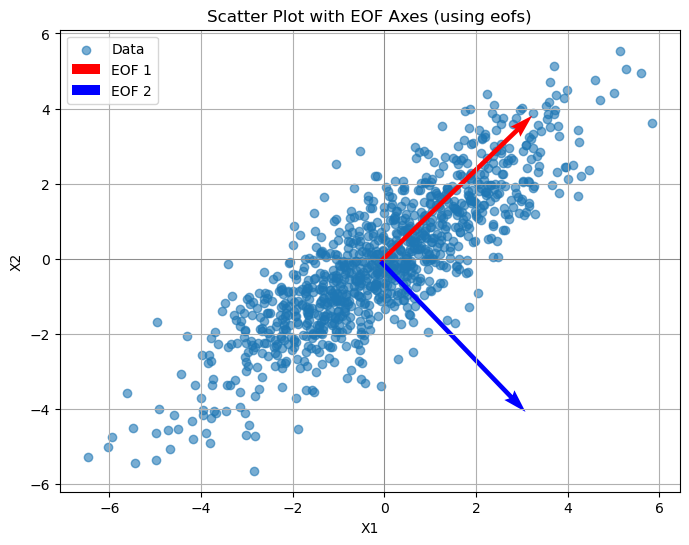
How did we do that?
data.shape # is already (time, space)
(1000, 2)
data_mean = np.mean(data, axis=0)
data_anomalies = data - data_mean
cov_matrix = np.cov(data_anomalies, rowvar=False) # Covariance across space
eigenvalues, eigenvectors = np.linalg.eigh(cov_matrix) # Solve for eigenvalues/vectors
sorted_indices = np.argsort(eigenvalues)[::-1]
eigenvalues = eigenvalues[sorted_indices]
eigenvectors = -1*eigenvectors[:, sorted_indices]
pcs = np.dot(data_anomalies, eigenvectors)
plt.quiver(0, 0, eigenvectors[0][0],eigenvectors[0][1], color="red",alpha=.5)
plt.quiver(0, 0, eigenvectors[1][0],eigenvectors[1][1], color="red",alpha=.5)
<matplotlib.quiver.Quiver at 0x7faf0694c1d0>
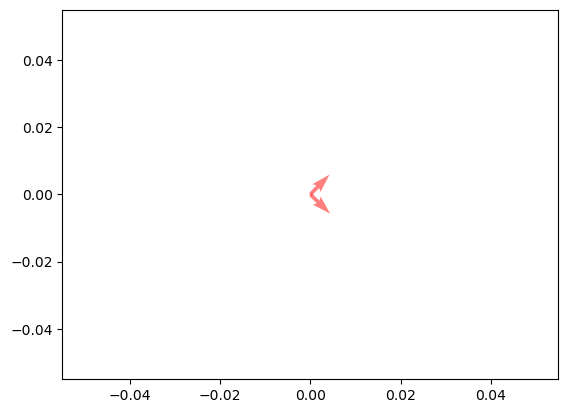
plt.quiver(0, 0, eigenvectors[0][0],eigenvectors[0][1], color="red",alpha=.5)
plt.quiver(0, 0, eigenvectors[1][0],eigenvectors[1][1], color="red",alpha=.5)
plt.quiver(0, 0, eofs.isel(mode=0)[0], eofs.isel(mode=0)[1],alpha=0.5)
plt.quiver(0, 0, eofs.isel(mode=1)[0], eofs.isel(mode=1)[1],alpha=.5)
<matplotlib.quiver.Quiver at 0x7faf0680d990>
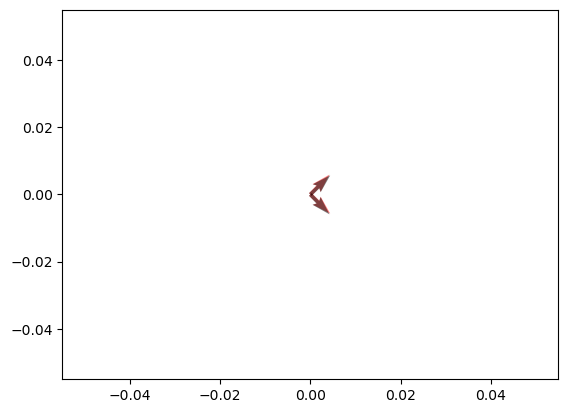
infile = "sst.mon.mean.nc"
dataset = xr.open_dataset(infile)
dataset.isel(time = 0).sst.plot()
<matplotlib.collections.QuadMesh at 0x7faf0684f050>
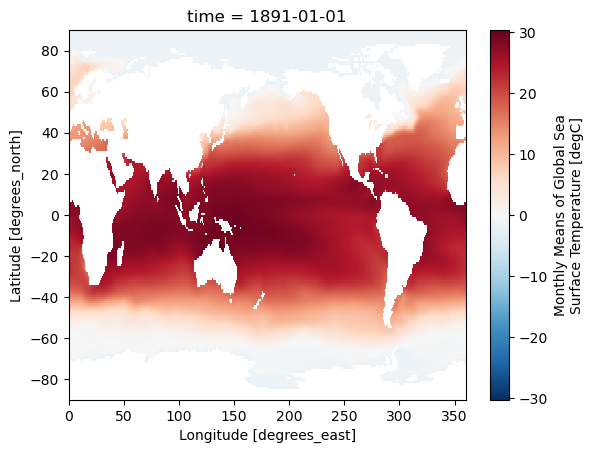
def detrend_dim(da, dim, deg=1):
"""
Detrend data along a specified dimension.
This function removes a polynomial trend along a given dimension by fitting
and subtracting a polynomial of specified degree.
Parameters
----------
da : xr.DataArray
The data array to detrend.
dim : str
The dimension along which to detrend the data, typically representing time.
deg : int, optional
The degree of the polynomial for detrending. Default is 1 (linear detrend).
Returns
-------
xr.DataArray
The detrended data array with the fitted trend removed along the specified dimension.
"""
p = da.polyfit(dim=dim, deg=deg)
fit = xr.polyval(da[dim], p.polyfit_coefficients)
return da - fit
detrendedSST = detrend_dim(dataset['sst'], dim="time")
monthly_mean = detrendedSST.groupby('time.month').mean('time')
sst_deseasonalized = detrendedSST.groupby('time.month') - monthly_mean
sst_deseasonalized = sst_deseasonalized.drop("month")
coslat = np.cos(np.deg2rad(dataset.lat.data))
wgts = np.sqrt(coslat)[..., np.newaxis]
solver = Eof(sst_deseasonalized, weights=wgts)
eof1 = solver.eofs(neofs=10)
pc1 = solver.pcs(npcs=10, pcscaling=0)
varfrac = solver.varianceFraction()
lambdas = solver.eigenvalues()
# Define parallels and meridians
parallels = np.arange(-90, 90, 30.)
meridians = np.arange(-180, 180, 30.)
# Define lon and lat
lon = dataset.lon
lat = dataset.lat
for i in range(0, 1):
fig = plt.figure(figsize=(12, 12)) # Larger figure for better clarity
# --- Plot EOF Field ---
ax1 = plt.subplot(2, 1, 1, projection=ccrs.Robinson(central_longitude=180))
# Plot EOF with proper transformation
cs = eof1.isel(mode=i).plot(
ax=ax1,
cmap=plt.cm.RdBu,
transform=ccrs.PlateCarree(),
add_colorbar=False # Avoid duplicate colorbars
)
# Add coastlines and gridlines
ax1.coastlines()
gl = ax1.gridlines(draw_labels=True, linewidth=1, color='gray', alpha=0.5, linestyle='--')
gl.top_labels = False
gl.right_labels = False
gl.left_labels = True
gl.bottom_labels = True
# Add colorbar manually
cb = plt.colorbar(cs, ax=ax1, orientation='vertical', fraction=0.05, pad=0.05)
cb.set_label('EOF', fontsize=12)
# Title
ax1.set_title(f'EOF {i + 1}', fontsize=16)
# --- Plot PC Time Series ---
ax2 = plt.subplot(2, 1, 2)
pc1.isel(mode=i).plot(ax=ax2, linewidth=2, color='blue')
ax2.axhline(0, color='k', linewidth=0.8)
ax2.set_xlabel('Year', fontsize=12)
ax2.set_ylabel('PC Amplitude', fontsize=12)
ax2.set_ylim(np.min(pc1), np.max(pc1))
ax2.set_title(f'PC Time Series - Mode {i + 1}', fontsize=14)
ax1.set_aspect("auto")
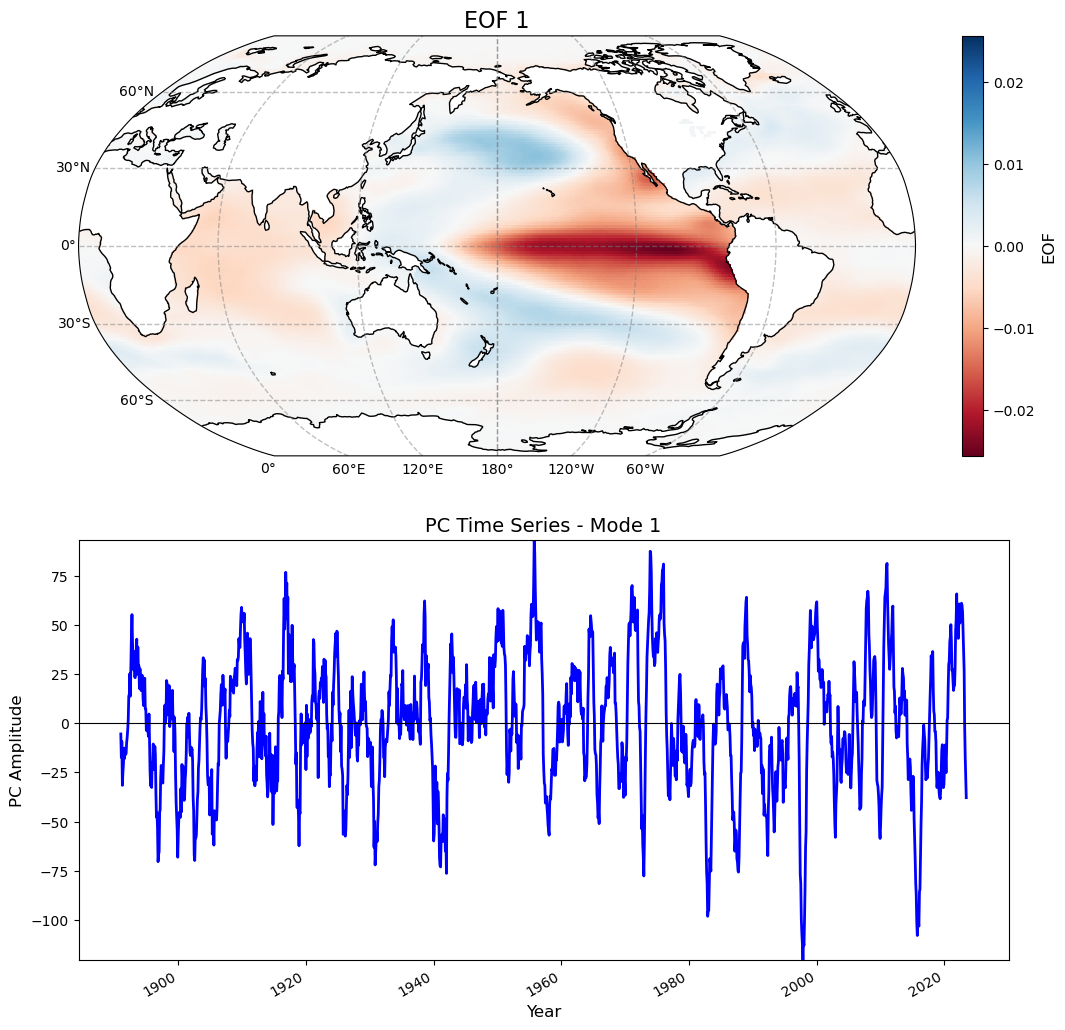
plt.plot(varfrac.isel(mode=slice(0,10)), ls="", marker=".")
[<matplotlib.lines.Line2D at 0x7faf06aa00d0>]
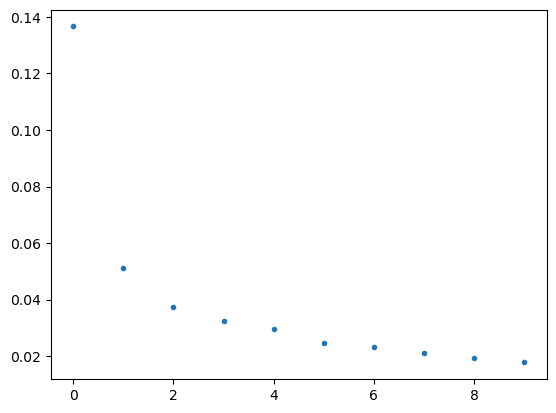
slp = xr.open_dataset("/students_files/data/SLP.nc").msl
slp
<xarray.DataArray 'msl' (time: 1320, latitude: 181, longitude: 360)>
[86011200 values with dtype=float32]
Coordinates:
* longitude (longitude) float32 0.0 1.0 2.0 3.0 ... 356.0 357.0 358.0 359.0
* latitude (latitude) float32 90.0 89.0 88.0 87.0 ... -88.0 -89.0 -90.0
* time (time) datetime64[ns] 1900-01-01 1900-02-01 ... 2009-12-01
Attributes:
units: Pa
long_name: Mean sea level pressure
standard_name: air_pressure_at_mean_sea_level#| export
def adjust_lon_lat(ds, lon_name, lat_name, reverse = False):
"""Adjusts longitude from 0 to 360 to -180 to 180 and reverses latitude."""
if reverse == True:
ds = ds.reindex({lat_name:ds[lat_name][::-1]})
ds['_longitude_adjusted'] = xr.where(
ds[lon_name] > 180,
ds[lon_name] - 360,
ds[lon_name])
ds = (ds
.swap_dims({lon_name: '_longitude_adjusted'})
.sel(**{'_longitude_adjusted': sorted(ds._longitude_adjusted)})
.drop(lon_name))
ds = ds.rename({'_longitude_adjusted': lon_name})
return ds
slp = adjust_lon_lat(slp, lon_name="longitude", lat_name="latitude", reverse=True)
slp.isel(time=0).plot()
<matplotlib.collections.QuadMesh at 0x7faeffafc790>
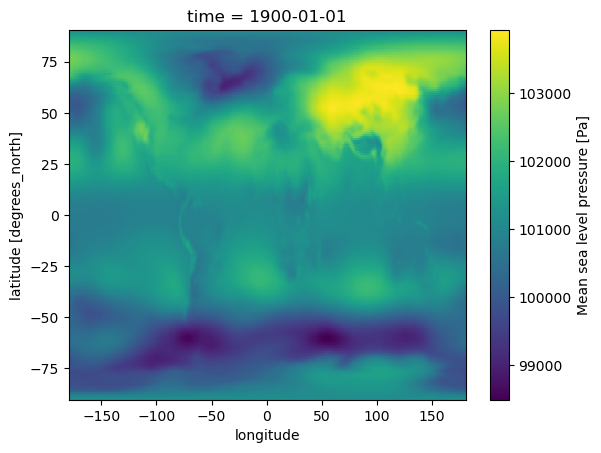
slp_djf
<xarray.DataArray 'msl' (time: 330, latitude: 0, longitude: 41)> array([], shape=(330, 0, 41), dtype=float32) Coordinates: * longitude (longitude) float32 0.0 1.0 2.0 3.0 4.0 ... 37.0 38.0 39.0 40.0 * latitude (latitude) float32 * time (time) datetime64[ns] 1900-01-01 1900-02-01 ... 2009-12-01
slp_djf = slp.sel(time=slp['time'].dt.month.isin([12, 1, 2]))
slp_djf = slp_djf.sel(longitude=slice(-80,40), latitude=slice(20,90))
# Compute anomalies by removing the time-mean.
slp_djf = slp_djf - slp_djf.mean(dim='time')
# Create an EOF solver to do the EOF analysis. Square-root of cosine of
# latitude weights are applied before the computation of EOFs.
coslat = np.cos(np.deg2rad(slp_djf.coords['latitude'].values)).clip(0., 1.)
wgts = np.sqrt(coslat)[..., np.newaxis]
solver = Eof(slp_djf, weights=wgts)
# Retrieve the leading EOF, expressed as the covariance between the leading PC
# time series and the input SLP anomalies at each grid point.
eof1 = solver.eofsAsCovariance(neofs=1)
# Plot the leading EOF expressed as covariance in the European/Atlantic domain.
proj = ccrs.Orthographic(central_longitude=-20, central_latitude=60)
ax = plt.axes(projection=proj)
ax.coastlines()
ax.set_global()
eof1.isel(mode=0).plot.pcolormesh(ax=ax, cmap=plt.cm.RdBu_r,
transform=ccrs.PlateCarree(), add_colorbar=False)
ax.set_title('EOF1', fontsize=16)
plt.show()
